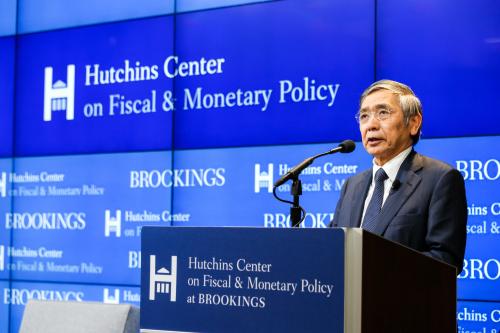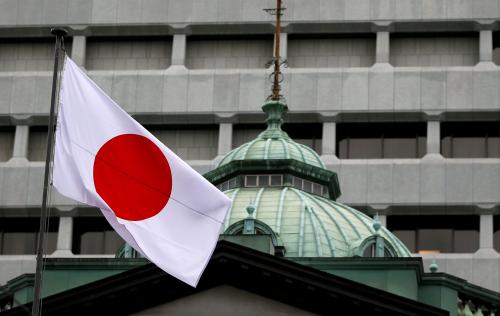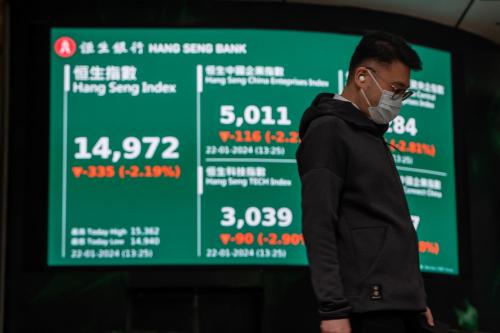The Bank of Japan’s (BOJ) policy announcement today had two main parts. First, the BOJ committed itself to continue expanding the monetary base until the inflation rate “exceeds the price stability target of 2 percent and stays above the target in a stable manner.” That is, the BOJ says it wants not only to reach its 2 percent inflation target but to overshoot it. Second, in a significant change, the BOJ will begin targeting the yield on ten-year Japanese government debt (JGBs), initially at about zero percent (that is, setting a target price for bonds). However, the Bank muddled that message by indicating that it also plans to continue to buy about 80 trillion yen in JGBs annually, a quantity target.
Market reactions to the BOJ’s announcements have been mixed, likely because the announcements were about a change in policy framework, not a change in policy stance per se. In particular, the announced target for the ten-year JGB yield is close to its current market rate, and no significant changes were made to other parts of the BOJ’s program, including the negative interest rate on bank reserves, still at -0.1 percent. Although the BOJ did not take substantial new easing measures, I think the announcements are good news overall, since they include a recommitment to the goal of ending deflation in Japan and the establishment of a new framework for pursuing that goal. As the BOJ noted explicitly, the Bank will now be able to cut either the short-term rate or its target for the longer-term JGB yield if future policy easing is needed. The follow-through will indeed be crucial: Japan has made significant progress toward ending deflation, but that progress could still be lost if the public questions the BOJ’s commitment to its inflation objective. The commitment to overshoot the inflation target will be constructive if it helps to kill market speculation that the BOJ was contemplating abandoning its fight.
The most surprising, and interesting, part of the announcement was the decision to target the ten-year JGB yield. As I noted in a previous piece on targeting longer-term rates, there is a U.S. precedent for the BOJ’s new strategy: The Federal Reserve targeted long-term yields during and immediately after World War II, in an effort to hold down the costs of war finance.
Targeting a long-term yield is closely related to quantitative easing. In a quantitative easing program, the central bank specifies the quantity of financial assets (such as government bonds) that it plans to buy, leaving the price of those assets (the yield, in the case of bonds) to be set in the market. Pegging a long-term yield, as the BOJ now plans to do, amounts to setting a target price rather than a target quantity. The central bank posts the price at which it stands ready to buy or sell bonds, but the quantity actually purchased depends on how much market participants offer to sell at that price.
In that regard, it was puzzling that the BOJ retained its 80-trillion-yen quantity target for JGB purchases; one of these two targets is redundant. I presume that the BOJ was concerned that dropping the quantity target would lead market participants to infer (incorrectly) that the Bank was scaling back its program of monetary easing. Over time, assuming that the BOJ does adhere to its new rate peg, the redundant quantity target is likely to become softer and to recede in importance. The BOJ’s communication will accordingly begin to emphasize the yield on JGBs, rather than the quantity of bonds in the BOJ’s portfolio, as the better indicator of the degree of monetary policy ease.
Is the BOJ’s switch to a long-term rate peg a good idea? In general, pegging a long-term rate carries some risks. Notably, in defending a peg, a central bank gives up control over the size of its balance sheet, committing to buy whatever supply of bonds is forthcoming at the target rate. In the extreme case, a central bank trying to hold down yields could find itself owning most or all of the eligible securities. That risk is particularly acute if the peg is not credible—if market participants expect the peg to be abandoned in the near term, for example—because then bondholders will have a strong incentive to sell as quickly as possible.
Although the BOJ will want to monitor closely the effects of its announcement on the JGB market, in the Japanese context these risks are probably manageable. Importantly, the BOJ already owns a substantial portion of outstanding JGBs, and those bonds still in private hands are not very price-sensitive (because banks and other holders value JGBs for reasons other than yield). The result may be that the BOJ will be able to meet its yield target by buying considerably less than 80 trillion yen a year of JGBs going forward. Since constraints on the availability of JGBs were seen in many quarters as limiting the BOJ’s ability to maintain its easy policies beyond the next year or two, the new framework may be seen as more sustainable. Together with the commitment to overshoot the inflation target, that sustainability should enhance the long-term credibility of the program. Finally, the BOJ has been concerned about the effects of long-term yields on bank profitability and financial stability. From that perspective, a rate-pegging strategy brings the additional benefit of allowing the BOJ to mitigate the risk of large, destabilizing swings in those yields.
The BOJ’s announcement referred to “synergy effects” between Japanese monetary and fiscal policies, but in public statements Governor Kuroda has expressed his opposition to explicit monetary financing of government spending, so-called “helicopter money.” Exactly what constitutes helicopter money is a semantic debate, but a policy of keeping the government’s borrowing rate at zero indefinitely has some elements of monetary finance. (As noted, the Fed’s targeting policy during and after World War II was explicitly about reducing the costs of government borrowing.) The resemblance would become even more pronounced if the BOJ began targeting rates on very long JGBs (the Japanese government borrows at maturities out to forty years). I suspect that the BOJ is happy for now with “synergy,” as opposed to explicit fiscal-monetary cooperation. Whether such cooperation will emerge in the future will depend on whether the new framework proves powerful enough to decisively end deflation in Japan.
Comments are now closed for this post.







Commentary
The latest from the Bank of Japan
September 21, 2016